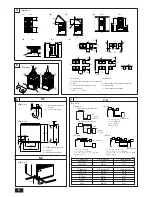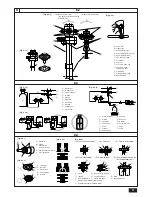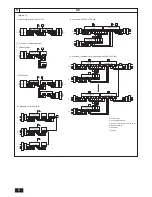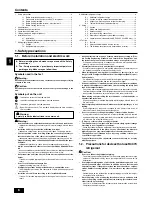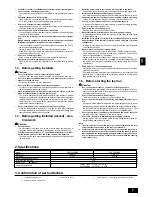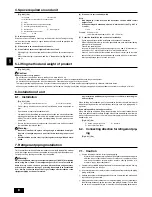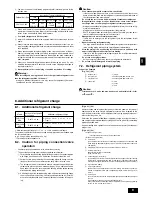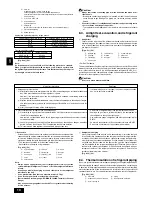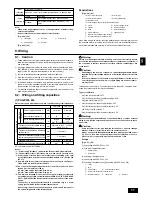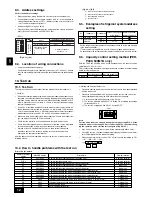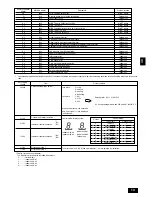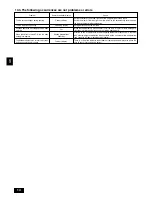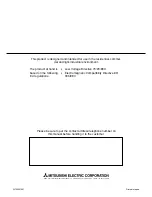
12
GB
D
F
I
NL
E
SW
P
9.4. Location of wiring connections
•
Using the conduit mounting plates
Conduit mounting plates are supplied in three sizes (ø27, ø34, ø40). Choose
the size of mounting plate that matches the outer diameter of the conduit being
used.
9.3. Address settings
Outdoor unit address settings
•
When controlling a group, the address must be set for each outdoor unit.
•
During address setting, set all the dip switches SW1 (3 - 6) on the board to
<when shipped from factory: all OFF>. (Address setting is not necessary for
1:1 or Free multi-component systems.)
•
Settings using SW1 are given below.
•
Please set the mutually different address, and prevent the start up simultane-
ously. (In case of connecting with PEH-P400, 500)
10. Test run
10.1. Test run
The test run can be carried out either from the outdoor unit or the indoor unit.
1. Checklist
•
After the installation, piping setup, and wiring of the indoor and outdoor units is
complete, check that refrigerant is not leaking, the power and control wires are
not loose, and the poles are not reversed. (When connecting model PEH-(R)P-
MYA in particular, check that there is current in the separate power supply
cable for the indoor unit.)
•
Use a 500 V insulation resistance tester to make sure that the resistance be-
tween the power terminal and the ground is 1.0 M
Ω
or more. If it is less than
1.0 M
Ω
, do not operate the unit. * Absolutely do not touch the tester to indoor/
outdoor connection terminals S1, S2, and S3. An accident could occur.
•
Make sure there is no malfunction in the outdoor unit. (If there is a malfunction,
you can diagnose it using LED1 on the board.)
•
Check that the ball valve is fully open on both the liquid and gas ends.
•
Check the electrical power phase. If the phase is reversed, the fan may rotate
in the wrong direction or stop, or unusual sounds may be produced.
•
Starting at least 12 hours before the test run, send current through the
crankcase heater. (If the current is running for a shorter period of time,
damage to the compressor could result.)
After the above checks are complete, carry out the test run as indicated in the
following outline.
2. Starting and finishing the test run
•
Procedure from the indoor unit: carry out the test run as in the manual provided
with the indoor unit.
•
Procedure from the outdoor unit: start and stop the test run and set test run
mode (cooling/heating) using the SW4 dip switches on the board.
1
Set test run mode (cooling/heating) using SW 4-2.
2
The test run will begin when SW 4-1 is turned ON, according to the mode
selected by SW 4-2.
3
The test run is stopped when SW 4-1 is turned OFF.
Note:
Test run mode cannot be stopped during operation by using SW 4-2. (If the
operation mode is to be changed, first stop it using SW 4-1, then after chang-
ing the operation mode, start the test run again using SW 4-1.)
•
If the 2-hour timer is set, the test run will stop automatically after 2 hours.
•
During the test run, the room temperature display on the indoor unit will indi-
cate the temperature of the indoor unit piping.
•
When you operate the test run from OC1, all trial runs are completed by OC1
→
IC1
→
MA
→
IC1
→
OC2.
cooling
run
<SW4>
heating
ON
1
2
stop
OFF
PEH-P400, 500
(IC1)
MA
OC1
OC2
SW1 function
switching
2 Error history clear
Operation by switch manipulation
Clear
Outdoor unit address
Settings 0 - 15
OFF
ON
1
2
3
4
5
6
ON
OFF
(SW1)
Ordinary
[Fig. 9.3.1] (P.5)
Model
1
–
3 Refrigerant system
address setting
4
↑
5
↑
6
↑
–
–
9.5. Examples of refrigerant system address
setting
Ex.
1
2
* Set the refrigerant system address of one outdoor unit to 00 for the power supply
to the remote controller.
(The refrigerant system address is set to 00 when shipped from the factory.)
Do not duplicate the refrigerant system address settings within the same system.
Indoor unit
PEH-RP200, 250MYA
PEH-P400,
500MYA
Outdoor unit
–
No.1
No.2
Outdoor unit refrigerant
system address
00
00
01~15
Remote controller
power supply unit
✕
9.6. Capacity control setting method (PEH-
P400, 500MYA only)
With the PEH-P400, 500MYA which has two outdoor units, the capacity can be
controlled to 0%, 50% or 100%.
This is set by setting the outdoor unit side dip switches as shown in the table below
before turning the power on.
DipSW5-1
No.1 side outdoor unit
OFF
No.2 side outdoor unit
ON
[Fig. 9.4.1] (P.5)
A
When installing conduct from bottom panel
B
When installing conduct from front panel
C
Mounting plate (attached)
D
Knock-out hole
Remote controller communication – reception error
Remote controller board error
Remote controller communication – transmission error
Remote controller communication – reception error
Remote controller communication – transmission error
Communication between indoor and outdoor units – reception error
Communication between indoor and outdoor units – transmission error
Communication between indoor and outdoor units – reception error
Communication between indoor and outdoor units – transmission error
Indoor/outdoor connection wiring error, indoor unit overload (5 units or more)
Indoor/outdoor connection wiring error (interference, loose)
Excessive time in use
Serial communication error
Error details
Problem location
Remote Controller
Remote Controller
Remote Controller
Indoor unit
Indoor unit
Indoor unit
Indoor unit
Outdoor unit
Outdoor unit
Outdoor unit
Outdoor unit
Outdoor unit
Outdoor unit
10.2. How to handle problems with the test run
Error code list: details
MELANS display
6831,6834
6201,6202
6832,6833
6831,6834
6832,6833
6740,6843
6841,6842
6840,6843
6841,6842
6844
6845
6846
0403
Remote controller
display
E0
E1, E2
E3
E4
E5
E6
E7
E8
E9
EA
EB
EC
ED


